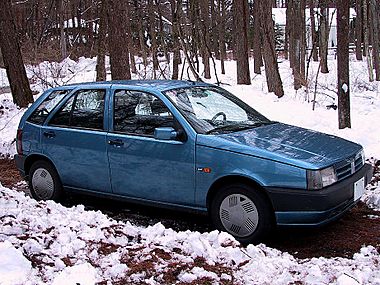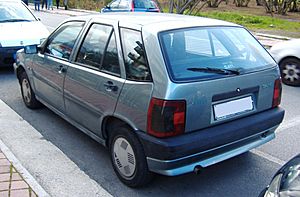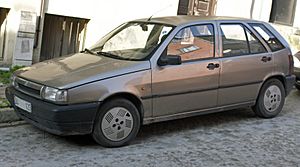Fiat Tipo (Type 160) facts for kids
Quick facts for kids Fiat Tipo |
|
|---|---|
 |
|
| Overview | |
| Manufacturer | Fiat Auto |
| Production | 1988–1995 (Italy) 1995-1997 (Brazil) 1995-2000 (Turkey) |
| Assembly | Cassino Plant – Piedimonte San Germano (FR), Italy Alfa Romeo Pomigliano d'Arco plant, Italy (1989-1990) Betim, Brazil Bursa, Turkey (Tofaş) |
| Designer | Ercole Spada at I.DE.A Institute |
| Body and chassis | |
| Class | Small family car (C) |
| Body style | 3/5-door hatchback |
| Layout | front-engine, front-wheel-drive |
| Platform | Type Two (Tipo Due) |
| Related |
|
| Powertrain | |
| Engine | |
| Transmission | |
| Dimensions | |
| Wheelbase | 2,540 mm (100.0 in) |
| Length | 3,958 mm (155.8 in) |
| Width | 1,700 mm (66.9 in) |
| Height | 1,445 mm (56.9 in) |
| Weight | 1,020–1,230 kg (2,250–2,710 lb) |
| Chronology | |
| Predecessor | Fiat Ritmo |
| Successor | Fiat Bravo/Brava |
The Fiat Tipo (Type 160) was a popular compact car made by the Italian company Fiat. It was built from 1988 to 1995. The car was designed by a company called I.DE.A Institute.
The Tipo was first sold as a five-door hatchback (a car with a back door that swings up). It was special because its body panels were made from galvanized metal, which helped stop rust. The car was built on a brand new platform, which is like the base structure of a car. This same platform was later used for other cars from Alfa Romeo and Lancia.
The Tipo had a boxy shape, which made it surprisingly roomy inside, especially for passengers in the back. Even though it was similar in size to the smaller Ford Escort, it had more space than a larger car like the Ford Sierra. This smart design was similar to the smaller Fiat Uno, which came out five years before the Tipo.
In 1989, the Fiat Tipo won the important European Car of the Year award. It also won the 1989 Semperit Irish Car of the Year award in Ireland. The car became very popular in Brazil, where it even sold more than the Volkswagen Gol, which had been the best-selling car there for over twenty years! Only a few other Fiat models, like the Fiat Uno Mille and Fiat Palio, have managed to outsell the Gol.
Contents
Fiat Tipo Models and Features
The Fiat Tipo was first shown in January 1988 and went on sale in Europe in June 1988. In the United Kingdom, it started selling on July 16, 1988. At first, you could get it in different versions like base, DGT, S, SX, and 16v. The word "Tipo" simply means "type" in Italian.
The Tipo offered many different engine choices, from smaller 1.1-liter engines to more powerful 2.0-liter ones. There were also diesel engines available. The power of these engines ranged from about 58 to 148 horsepower.
The smallest 1.1-liter engine was often thought to be a bit weak for the car, even though the Tipo was roomy enough for five adults and had good features. This version was not sold in the United Kingdom. The most powerful version was the 2.0-liter Sedicivalvole, which means "16 valves" in Italian.
The Sedicivalvole model used an engine from the Lancia Thema. Because the Tipo was smaller and lighter, this engine gave it amazing performance and handling. It could reach a top speed of about 130 miles per hour (209 km/h), making it faster than the Volkswagen Golf GTI of that time. In the United Kingdom, only the 1.4 and 1.6-liter versions were sold at first. The more powerful 1.8 and 2.0-liter petrol engines and the diesel models arrived in the early 1990s.
Fiat had high hopes for the Tipo, especially after the smaller Fiat Uno was very successful in the 1980s. However, the Tipo's sales didn't quite meet those high expectations.
Updates and Changes to the Tipo
The Tipo received an update in 1993. A new three-door version was added, and there were small changes to the car's outside look. You can tell the older and newer models apart by their slightly different front grilles and headlights. The updated models also had better features, including safety improvements like stronger body structures, a driver's airbag, and side impact bars. New trim levels like S, SX, and SLX were introduced, along with a new 2.0 GT model.
Production of the Fiat Tipo stopped in the summer of 1995. It was replaced by two new models: the three-door Fiat Bravo and the five-door Fiat Brava. The Fiat Tempra sedan and station wagon models were replaced by the Fiat Marea. While the Bravo and Brava sold very well in Europe, the Marea was not as successful in most markets.
The Tipo was a fairly good seller in the United Kingdom. People liked its new and practical design, as well as how well it handled. Some of the higher-end models had a digital dashboard, which looked cool but sometimes had problems.
When the Tipo first came out, it faced less competition because other major carmakers hadn't released new cars of this size for a few years. However, within three years, many new rival cars appeared, like the Renault 19 and Citroën ZX. This increased competition led to fewer Tipo sales outside of Italy.
In its last two years (1994 and 1995), sales of the Tipo actually went up quite a bit, but these were mostly of the cheaper 1.4-liter models.
Where Else the Tipo Was Made
The Fiat Tipo was also produced in other countries. In Brazil, it started being made in 1995. These Brazilian models had a 1.6-liter engine with a special fuel injection system, which gave them a bit more power. Before 1995, Tipos were imported to Brazil from Italy.
The Tipo was also built in Turkey by a company called Tofaş. The cars made in Turkey usually didn't have catalytic converters, which meant they sometimes had slightly more power. Turkish-built Tipos can be identified by a small "Tofaş" logo on the back. Production in Turkey continued until at least the year 2000.
Engine Types
The Fiat Tipo was available with several different petrol and diesel engines. Here's a look at some of them:
Petrol Engines
| Model | Engine Code | Catalytic Converter | Size | Power | Torque |
|---|---|---|---|---|---|
| 1.1 FIRE | 160A3.000 | — | 1,108 cc | 56 PS (41 kW; 55 hp) at 5,500 rpm | 89 N⋅m (66 lb⋅ft) at 2,900 rpm |
| 1.4 i.e., S | 160A1.046 | 1,372 cc | 70 PS (51 kW; 69 hp) at 6,000 rpm | 106 N⋅m (78 lb⋅ft) at 3,000 rpm | |
| 159A2.000 | — | 78 PS (57 kW; 77 hp) at 6,000 rpm | 108 N⋅m (80 lb⋅ft) at 2,900 rpm | ||
| 1.4, DGT | 160A1.000 | — | 1,372 cc | 71 PS (52 kW; 70 hp) at 6,000 rpm | 105 N⋅m (77 lb⋅ft) at 3,750 rpm |
| 160A1.048 | 72 PS (53 kW; 71 hp) at 6,000 rpm | 105 N⋅m (77 lb⋅ft) at 3,750 rpm | |||
| 1.6 i.e. | 159A3.046 | 1,581 cc | 80 PS (59 kW; 79 hp) at 6,000 rpm | 128 N⋅m (94 lb⋅ft) at 3,000 rpm | |
| 159A3.048 | 76 PS (56 kW; 75 hp) at 6,000 rpm (ECE) | 124 N⋅m (91 lb⋅ft) at 3,000 rpm | |||
| 1.6 DGT | 160A2.000 | — | 1,581 cc | 86 PS (63 kW; 85 hp) at 5,800 rpm | 132 N⋅m (97 lb⋅ft) at 2,900 rpm |
| 82 PS (60 kW; 81 hp) at 6,000 rpm (ECE) | 130 N⋅m (96 lb⋅ft) at 2,900 rpm | ||||
| 1.6 i.e. | 149.C2.046 | 1,585 cc | 90 PS (66 kW; 89 hp) at 6,250 rpm | 122 N⋅m (90 lb⋅ft) at 4,250 rpm | |
| 1.7 i.e. or 1.6 S i.e. 1994-1996: Export model Germany, Greece, Brazil (17 sold), Turkey |
1,676 cc | 90 PS (66 kW; 89 hp) at 5,900 rpm | 130 N⋅m (96 lb⋅ft) at 3,000 rpm | ||
| 1.8 i.e. | 159A4.000 | — | 1,756 cc | 110 PS (81 kW; 108 hp) at 6,000 rpm | 142 N⋅m (105 lb⋅ft) at 2,500 rpm |
| 1.8 i.e. 16V Sedicivalvole | 160A5.000 | — | 1,756 cc | 138 PS (101 kW; 136 hp) at 6,250 rpm | 167 N⋅m (123 lb⋅ft) at 4,600 rpm |
| 2.0 i.e. | 159A6.046 | 1,995 cc | 115 PS (85 kW; 113 hp) at 5,750 rpm | 159 N⋅m (117 lb⋅ft) at 3,300 rpm | |
| 159A5.046 | 109 PS (80 kW; 108 hp) at ? rpm | ? at ? rpm | |||
| 2.0 i.e. 16V Sedicivalvole | 160A8.046 | 1,995 cc | 148 PS (109 kW; 146 hp) at 6,250 rpm | 173 N⋅m (128 lb⋅ft) at 5,000 rpm | |
| 2.0 i.e. 16V Sport | 836A3.000 | 1,995 cc | 142 PS (104 kW; 140 hp) at 6,000 rpm | 180 N⋅m (133 lb⋅ft) at 4,500 rpm (CEE) |
Diesel Engines
| Model | Engine Code | Size | Power | Torque |
|---|---|---|---|---|
| 1.7 D, DS | 149B4.000 | 1,697 cc | 58 PS (43 kW; 57 hp) at 4,600 rpm | 100 N⋅m (74 lb⋅ft) at 2,900 rpm |
| 1.9 DS DGT | 160A7.000 | 1,929 cc | 65 PS (48 kW; 64 hp) at 4,600 rpm | 119 N⋅m (88 lb⋅ft) at 2,000 rpm |
| 1.9 T.ds, DSX | 850A6.000 | 1,929 cc | 92 PS (68 kW; 91 hp) at 4,100 rpm | 190 N⋅m (140 lb⋅ft) at 2,400 rpm |
Cars Built on the Tipo Platform
The Tipo's platform (its basic structure) was very versatile! It was used to create nine other cars. Some of these cars include:
- The Yugo Sana/Zastava Florida (November 1988)
- The Lancia Dedra sedan (April 1989)
- The Fiat Tempra (February 1990)
- The large family car Alfa Romeo 155 (1993)
- The coupé Fiat Coupé (1993)
- The Lancia Delta Nuova (1993)
- The Alfa Romeo 145 and 146 (1994-1995)
- The Alfa Romeo Spider and GTV (1994-1995), which had some special changes to its suspension.
See also
 In Spanish: Fiat Tipo (1988) para niños
In Spanish: Fiat Tipo (1988) para niños




